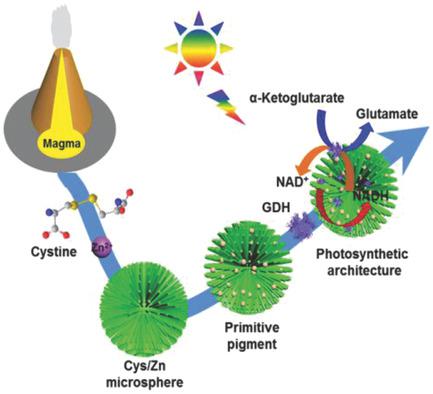Our official English website, www.x-mol.net, welcomes your
feedback! (Note: you will need to create a separate account there.)
Primitive Photosynthetic Architectures Based on Self‐Organization and Chemical Evolution of Amino Acids and Metal Ions
Advanced Science ( IF 14.3 ) Pub Date : 2018-03-09 , DOI: 10.1002/advs.201701001 Kai Liu 1, 2 , Xiaokang Ren 1, 2 , Jianxuan Sun 1 , Qianli Zou 1 , Xuehai Yan 1, 2, 3
Advanced Science ( IF 14.3 ) Pub Date : 2018-03-09 , DOI: 10.1002/advs.201701001 Kai Liu 1, 2 , Xiaokang Ren 1, 2 , Jianxuan Sun 1 , Qianli Zou 1 , Xuehai Yan 1, 2, 3
Affiliation

|
The emergence of light‐energy‐utilizing metabolism is likely to be a critical milestone in prebiotic chemistry and the origin of life. However, how the primitive pigment is spontaneously generated still remains unknown. Herein, a primitive pigment model based on adaptive self‐organization of amino acids (Cystine, Cys) and metal ions (zinc ion, Zn2+) followed by chemical evolution under hydrothermal conditions is developed. The resulting hybrid microspheres are composed of radially aligned cystine/zinc (Cys/Zn) assembly decorated with carbonate‐doped zinc sulfide (C‐ZnS) nanocrystals. The part of C‐ZnS can work as a light‐harvesting antenna to capture ultraviolet and visible light, and use it in various photochemical reactions, including hydrogen (H2) evolution, carbon dioxide (CO2) photoreduction, and reduction of nicotinamide adenine dinucleotide (NAD+) to nicotinamide adenine dinucleotide hydride (NADH). Additionally, guest molecules (e.g., glutamate dehydrogenase, GDH) can be encapsulated within the hierarchical Cys/Zn framework, which facilitates sustainable photoenzymatic synthesis of glutamate. This study helps deepen insight into the emergent functionality (conversion of light energy) and complexity (hierarchical architecture) from interaction and reaction of prebiotic molecules. The primitive pigment model is also promising to work as an artificial photosynthetic microreactor.
中文翻译:

基于氨基酸和金属离子自组织和化学进化的原始光合结构
利用光能的新陈代谢的出现可能是生命起源前化学和生命起源的一个重要里程碑。然而,原始色素是如何自发产生的仍然未知。在此,开发了一种基于氨基酸(胱氨酸、Cys)和金属离子(锌离子、Zn 2+ )自适应自组织以及水热条件下化学演化的原始色素模型。由此产生的杂化微球由径向排列的胱氨酸/锌(Cys/Zn)组装体组成,并用碳酸盐掺杂的硫化锌(C-ZnS)纳米晶体装饰。 C-ZnS部分可以作为光捕获天线来捕获紫外线和可见光,并将其用于各种光化学反应,包括氢气(H 2 )析出、二氧化碳(CO 2 )光还原和烟酰胺腺嘌呤还原二核苷酸(NAD + )转化为烟酰胺腺嘌呤二核苷酸氢化物(NADH)。此外,客体分子(例如谷氨酸脱氢酶,GDH)可以封装在分层的Cys/Zn框架内,这有利于谷氨酸的可持续光酶合成。这项研究有助于加深对益生元分子相互作用和反应的新兴功能(光能转换)和复杂性(层次结构)的了解。原始色素模型也有望用作人工光合作用微反应器。
更新日期:2018-03-09
中文翻译:

基于氨基酸和金属离子自组织和化学进化的原始光合结构
利用光能的新陈代谢的出现可能是生命起源前化学和生命起源的一个重要里程碑。然而,原始色素是如何自发产生的仍然未知。在此,开发了一种基于氨基酸(胱氨酸、Cys)和金属离子(锌离子、Zn 2+ )自适应自组织以及水热条件下化学演化的原始色素模型。由此产生的杂化微球由径向排列的胱氨酸/锌(Cys/Zn)组装体组成,并用碳酸盐掺杂的硫化锌(C-ZnS)纳米晶体装饰。 C-ZnS部分可以作为光捕获天线来捕获紫外线和可见光,并将其用于各种光化学反应,包括氢气(H 2 )析出、二氧化碳(CO 2 )光还原和烟酰胺腺嘌呤还原二核苷酸(NAD + )转化为烟酰胺腺嘌呤二核苷酸氢化物(NADH)。此外,客体分子(例如谷氨酸脱氢酶,GDH)可以封装在分层的Cys/Zn框架内,这有利于谷氨酸的可持续光酶合成。这项研究有助于加深对益生元分子相互作用和反应的新兴功能(光能转换)和复杂性(层次结构)的了解。原始色素模型也有望用作人工光合作用微反应器。











































 京公网安备 11010802027423号
京公网安备 11010802027423号